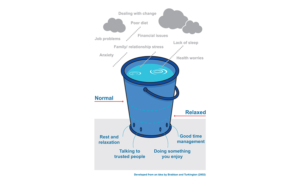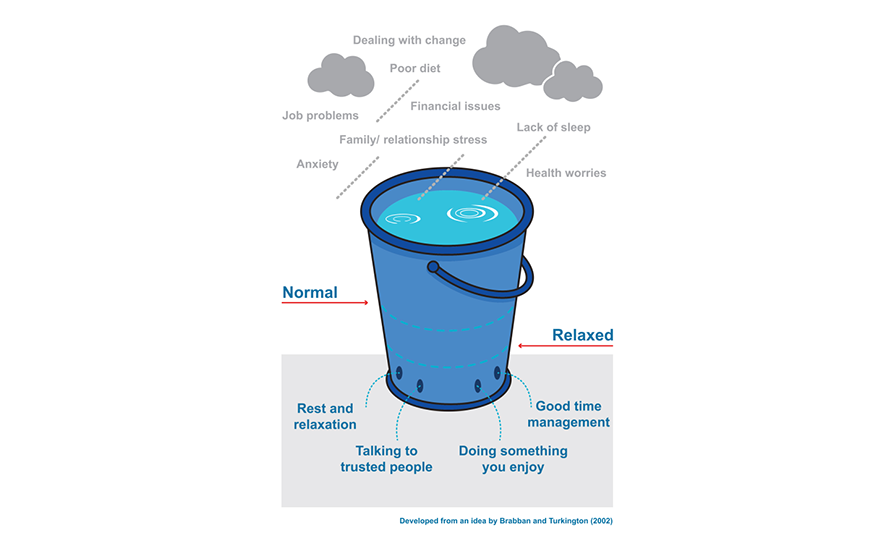I had the good fortune to attend a “Mental health in the workplace” seminar earlier this week. Of the many interesting facts and ideas shared with the audience, one particularly resonated with me. The speakers from Mental Health UK talked about the concept of a stress bucket. You can find more information on their website but here is my take on the idea.
 The ‘stress bucket’ has a number of feeds (rain clouds in the diagram) which are the things that cause us stress. They could be work related, but also from our personal lives, health or even wider factors that we can’t necessarily control but increase our stress level. At the bottom of the bucket are outlets (I think of them as taps), which we use to reduce our stress. Examples could be exercise, socialising or listening to music. Over time our stress levels go up and down depending on the flow of stress into our bucket and how much stress we release through our taps.
The ‘stress bucket’ has a number of feeds (rain clouds in the diagram) which are the things that cause us stress. They could be work related, but also from our personal lives, health or even wider factors that we can’t necessarily control but increase our stress level. At the bottom of the bucket are outlets (I think of them as taps), which we use to reduce our stress. Examples could be exercise, socialising or listening to music. Over time our stress levels go up and down depending on the flow of stress into our bucket and how much stress we release through our taps.
There were three key observations which I took away from the seminar and I want to use in my work and home life:
Firstly, everyone has a different size stress bucket. Some people have buckets the size of a skip, while for others it’s more like a thimble. That’s just the way it is, we can’t change it. In practice it means some people have more capacity for additional stress before they need to open their taps, while others have a limited capacity and need to keep opening taps. The flip side is also true; those with a smaller bucket can de-stress faster. We need to be sensitive to those around us and recognise how big their bucket is and do what we can to accommodate this and support them in managing their stress bucket.
Thinking about the stress bucket and how it works made me realise that as my stress bucket fills up, I tend to self-sabotage. I tell myself that I don’t have the time to do the things that are my ‘taps’ – exercise, read, meet up with friends … Not only does this prevent the release of stress, the fact that I know I should be doing these things adds more stress!
Related to this is the harsh reality that it’s almost impossible to help someone else with their stress levels, or in any other way if our own stress bucket is full. Managing our own stress bucket, opening our taps gives us capacity to help others and also sets a positive example to everyone around us. Taking time out to get back in balance when we need it isn’t selfish; it’s the first step to helping the colleagues, friends and family we want to support.
If this is a subject that interests you or you want to learn more about mental health in the workplace, there are two more seminars in October and November, click here to find out more.
Chris
